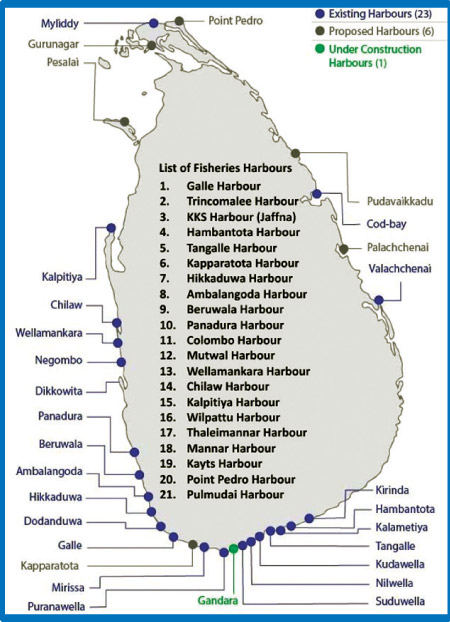
The Chamber of Marine Industries of Sri Lanka (CMISL) unveils a visionary five-year strategic plan designed to transform the nation’s maritime industry. This ambitious initiative focuses on fostering strategic partnerships, developing critical infrastructure, and implementing key regulatory reforms. By 2029, the plan aims to generate $ 2 billion in revenue, solidifying Sri Lanka’s position as a premier maritime hub in the Indian Ocean.
Leveraging the nation’s membership in the International Council of Marine Industry Associations (ICOMIA) and its pivotal geographic location, this strategy aspires to make Sri Lanka a leader in maritime innovation and economic prosperity. Sri Lanka’s maritime boat exports industry currently contributes 1.4% to the national GDP, valued at $ 78.
5 million in 2023. The marine sector including fisheries and boat manufacturing sector provides direct employment to 115,000 individuals and supports another 100,000 through related industries. Notably, the boat manufacturing industry alone has generated export income exceeding $ 200 million from 2019 to 2023.
This robust foundation, combined with Sri Lanka’s strategic location and expansive coastline, presents a unique opportunity for transformative growth. Through structured development and enhanced international collaboration, the maritime sector is poised to become a key driver of economic expansion, positioning Sri Lanka as a pivotal player in the global maritime economy. The $ 2 billion revenue target by 2029 is the brainchild of CMISL’s strategic plan, focusing on the development of the marine industry to realise this ambitious goal.
At the heart of this transformation lies an innovative dual-use harbour development strategy. This approach involves upgrading twenty-one existing fisheries harbours to cater to both commercial fishing and marine tourism. Major ports like Galle and Trincomalee are slated for significant enhancements to boost their operational capacity and appeal.
Additionally, regional harbours such as Beruwala, Mirissa, Point Pedro, and Kapparatota will undergo modernisation to ensure they meet the demands of a growing and evolving maritime industry. This strategic development aims to position Sri Lanka as a key maritime hub, fostering economic growth and supporting diverse marine activities. The manufacturing sector, currently consisting of 55 local boatyards and eight specialised export-oriented manufacturers, requires urgent support to meet growing demands.
One critical need is the development of slipway facilities in Negombo, Beruwala, and Welipatanwila. These areas house most of the inland boat and yacht manufacturing facilities, which lack direct access to slipways. Addressing this gap will streamline the transport of manufactured vessels from yards to launching points.
Strategically located slipway facilities will bolster manufacturing operations and promote efficiency. Additionally, infrastructure upgrades by the Road Development Authority (RDA) and Ceylon Electricity Board (CEB) are necessary. These include adjusting the height of overhead power lines and widening roads to facilitate the smooth transportation of boats and yachts.
We request the Government to release the ship/boat lifting equipment currently available at Mutwal Fisheries Harbour, which is under the purview of the Ministry of Fisheries, for use by the private sector. As this is the only available Ship/Boat lift of its capacity, aside from the one at Colombo Dockyard (CDL), it holds significant potential to enhance boat and yacht repair activities. This will greatly benefit local manufacturers by providing them with the necessary infrastructure to efficiently repair their boats, thereby reducing downtime and costs.
Leveraging this asset can substantially increase USD revenue for Sri Lanka. By repurposing this valuable resource, the government can support the growth of the marine and boat manufacturing industry, fostering economic development and strengthening the country’s position as a key player in the maritime sector. Trincomalee Deep-Water Port will be transformed into a specialised facility with a dry dock capable of servicing deep-draft vessels.
This transformation aims to attract foreign direct investment (FDI) from marine services firms that will establish their base in Trincomalee. Interested companies in the marine services sector are poised to prioritise investments, provided the necessary policy decisions are implemented efficiently. With minimal initial upgrades and essential infrastructure enhancements, Trincomalee can quickly become a hub for marine services, drawing substantial FDI and fostering the growth of ancillary industries.
Galle Port is set to be a premier destination for luxury yacht owners and a pivotal point for local maritime growth. By releasing Galle Port for mini marina operations, local boat and yacht owners will gain safe and secure anchorage. Additionally, local boat manufacturers will have the opportunity to showcase their vessels to an international clientele, fostering the “Grow Boating” concept in Sri Lanka.
This arrangement to release Galle Port for mini marina operations is a temporary measure until the Galle Port Mega Marina project is fully operational. This initiative will serve as a platform for expanding the network of mini marinas as they become available in the short to medium term, boosting nautical tourism and promoting local craftsmanship on a global stage. The strategic plan places a strong emphasis on integrating cutting-edge technologies to modernise and enhance the marine industry.
Virtual Reality (VR) and Artificial Intelligence (AI) will revolutionise maritime training, providing immersive and efficient learning experiences. The Internet of Things (IoT) and green propulsion systems will be implemented to modernise marine operations, ensuring greater efficiency and environmental sustainability. Advanced aquaculture technologies will promote sustainable fishing practices, while digital systems for data collection will enhance resource management, ensuring long-term growth and ecological balance.
The success of this ambitious initiative hinges on active Government involvement. Key areas of participation include: Enhanced access to private credit and Government-supported financial programs will stimulate both production and consumption in the boat manufacturing and ownership sectors, fostering a sustainable maritime ecosystem. CMISL’s active membership in ICOMIA facilitates access to international best practices and potential investment opportunities.
The strategic plan leverages these global connections to: The plan underscores the importance of sustainable development through the adoption of modern aquaculture technologies and responsible resource management. These efforts aim to support sustainable fishing practices and ensure fair market conditions for fishermen. To support industry growth, comprehensive workforce development programs will be launched.
These programs will focus on providing specialised technical training in emerging technologies and will be strategically located near key port areas. This initiative aims to build a skilled workforce capable of meeting the future demands of the marine industry while contributing to environmental sustainability. By 2029, this strategic vision aims to deliver transformative outcomes for Sri Lanka’s maritime sector, including: This comprehensive approach will drive sustainable economic growth, foster innovation, and solidify Sri Lanka’s status as a leading maritime hub in the Indian Ocean.
1. Market expansion and customer segments Objective: Expand international market reach and diversify customer segments, targeting luxury yacht owners, commercial shipping companies, and marine tourism operators. Plan: nInternational partnerships: Build relationships with international marine associations by attending trade shows and securing partnerships.
2. Industry development and investments Objective: Attract foreign direct investment (FDI) and strengthen local manufacturing to international standards. Plan: 3.
Technological advancements and innovation Objective: Modernise the maritime industry through technology integration and sustainable practices. Plan: 4. Emerging trends and nautical tourism Objective: Develop Sri Lanka as a leading destination for nautical tourism.
Plan: 5. Strategic partnerships and collaborations Objective: Establish alliances with global industry leaders and strengthen regional collaborations. Plan: Tracking and evaluation Timeline: The realisation of this transformative vision hinges on immediate and decisive government action to implement the regulatory framework developed by the Director General of Merchant Shipping.
This framework is pivotal in creating an enabling environment for investment, innovation, and sustainable growth in the maritime sector. To achieve these ambitious goals, sustained commitment and collaboration from all stakeholders are essential. The Government must expedite the approval and execution of this framework, while private sector stakeholders and international partners must actively engage in its implementation.
This collective effort will unlock Sri Lanka’s potential to become a maritime powerhouse in the Indian Ocean, driving economic prosperity, job creation, and sustainable development. Now is the time to act. By uniting in this shared vision, Sri Lanka can navigate towards a vibrant maritime future, securing economic growth and opportunities for future generations.
The path is clear, and the call to action is urgent—let’s seize this moment to transform Sri Lanka’s maritime destiny..














